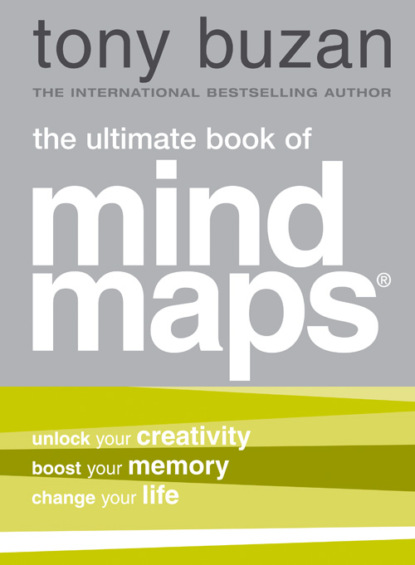По всем вопросам обращайтесь на: info@litportal.ru
(©) 2003-2024.
✖
The Ultimate Book of Mind Maps
Автор
Год написания книги
2018
Настройки чтения
Размер шрифта
Высота строк
Поля
a) A miniature toy house?
b) A doll’s house?
c) A house the size of a normal room?
d) An apartment?
e) A normal two-storey house?
f) A mansion?
g) A palace?
h) A 100-storey skyscraper?
i) Bigger than all the above?
By now it should be becoming apparent to you that your average brain cell dwarfs the capacity of the average personal computer, and the answer is in fact i) ‘bigger than all the above’!
In fact, if we were to represent the strength and power of the world’s greatest super-computer by that two-storey house, the potential power of your own brain would be represented by a building far bigger than the 100-storey skyscraper. The strength and power of your own brain would be represented by a heaven-scraper 10 blocks square at the base and reaching to the moon!
Different Parts, Different Functions
Another key revelation in the history of the brain was our realization that different parts of the brain control different functions.
When the brain started to evolve over 500 million years ago, it developed simultaneously from bottom to top and from back to front.
The different parts of the brain
The human brain evolved in the following order:
The brain stem, which controls life-supporting functions such as breathing and heart rate.
The cerebellum, or hind brain, which controls movements of the body in space and stores memories for basic learned responses.
The limbic system, which is slightly more forward in position and includes the thalamus and basal ganglia – the mid-brain. The limbic system is critical for learning and short-term memory but also maintains homeostasis in the body (blood pressure, body temperature, and blood-sugar levels).
The cerebrum, or cerebral cortex, which covers the rest of the brain and is significantly forward in its position. The cerebrum is the universe’s evolutionary masterpiece and is responsible for a vast range of skills including memory, communication, decision making, and creativity. It is the flower of evolution, it is the latest part of the brain to develop, and it is the part that allows us to Mind Map. Mind Mapping is a function of evolution’s highest masterpiece.
In the next couple of pages you will follow the history of evolution’s development of the brain and our intelligence, culminating in the cerebellum and the brain’s ability to Mind Map.
The Brain Stem
Evolved: 500 million years ago.
Common title: Reptilian Brain or Primitive Brain.
Location: Deep down in the brain, extending up from your spinal cord.
Functions: Basic life support. Handles breathing and heart rate. Masterminds general level of alertness. Alerts you to important incoming sensory information. Controls temperature. Controls the digestive process. Relays information from the cerebellum.
Interesting fact: Recent research seems to be suggesting that this area of your brain may be far more ‘intelligent’ than we had previously thought.
Recent studies of the giant reptiles, such as alligators and crocodiles, whose entire brain is basically the brain stem, have shown that they have highly evolved forms of social behaviour, deep family and group relationships, and emotions.
Next time you see one of these giant reptiles, live or on film, look more closely to see the magnificent brain stem in action!
The Cerebellum
Evolved: Approximately 400 million years ago.
Common title: Little Brain or Hind Brain.
Location: Attached to the rear of the brain stem – part of the lower brain.
Function: Controls body position, poise, and balance. Monitors movement in space. Stores memories for basic learned responses. Transmits vital information via the brain stem to the brain.
Interesting fact: In the human brain, the cerebellum has more than tripled in size in the last one million years.
The Limbic System
Evolved: Between 300 and 200 million years ago.
Common title: Mammalian Brain or Mid-Brain.
Location: Between the brain stem and the cortex.
Function: Maintains blood pressure, heart rate, body temperature, and blood-sugar levels. Governs navigational skills in the hippocampus. Critical to learning and for short-term and long-term memory, and stores memories of life experiences. Maintains homeostasis (constant environment) in the body. Involved in survival emotions of sexual desire or self-protection.
Interesting facts:
1 Scientist Robert Ornstein says: ‘One way to remember limbic functions is that they are the four ‘F’s of survival: feeding, fighting, fleeing and sexual reproduction.’
2 The limbic system contains the hypothalamus, often regarded as the most important part of the ‘mammalian brain’. It is often known as the ‘brain’ of the brain. Although tiny (about the size of half a sugar cube) and weighing only four grams, it regulates hormones, sexual desire, emotions, eating, drinking, body temperature, chemical balances, sleeping and waking, while at the same time masterminding the master gland of the brain, the pituitary.
3 The hippocampus is increasingly thought to be the seat of learning and memory. In shape it looks remarkably like a little seahorse.
Two other major areas of the mid-brain include the thalamus, which makes preliminary classifications of external information reaching the brain, and which relays information to the cortex via the hypothalamus. It is the hypothalamus that is the part of your brain which decides what comes to your attention and what does not – for example, telling you at which moment to notice that the room is getting warmer or that you are getting hungrier!
The basal ganglia, which are located on both sides of the limbic system (as is the cerebellum), are concerned with movement control, especially initiating movements. In the human brain (your brain) these networks have been growing larger and better developed over the last few million years.
The Cerebrum (Cerebral Cortex)
Evolved: Approximately 200 million years ago.
Common title: The left and right brain.
Location: Fits like a giant ‘thinking cap’ over the entire brain; extends into the full area of your forehead.











